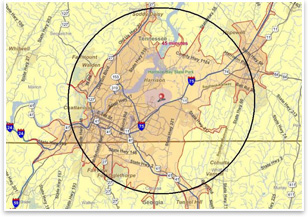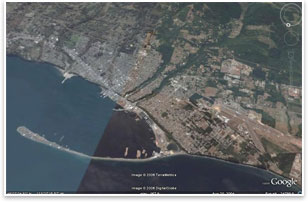| AIA Center for Communities by Design Names 10 SDAT Communities for 2009
Summary: The AIA Center for Communities by Design has selected 10 communities for participation in the 2009 Sustainable Design Assessment Team (SDAT) program. This community assistance program focuses on the principles of sustainability and brings teams of volunteer professionals (such as architects, urban designers, planners, hydrologists, economists, attorneys, and others) to work with community decision-makers and stakeholders to help them develop a vision and framework for a sustainable future. After a three-day visit, the multidisciplinary team compiles a report highlighting the strengths and weaknesses of the community with regard to sustainability, along with the opportunities and obstacles to change. The team is available for consultations and a follow-up visit one year later.
1. Beatrice, Neb. The SDAT will work with the community to find ways to reverse its current trend of degradation by helping the city lead a planning effort that will provide sustainably designed projects addressing:
- Environment: Water quality/quantity, open spaces, wildlife habitat, and wetlands
- Society: Public spaces, sense of community/place, pedestrian/bicycle trails (improving and expanding the city’s existing trail system)
- Economics: Revitalization and diversity in business and industry.
 2. Chattanooga. For the past 200 years, development and growth of the region has been steady with no extraordinary increases or decreases in any period. At this time Chattanooga is looking for a sustainable path to the future, as Volkswagen last year announced its plans to build a new $1 billion manufacturing facility and expectations are for significant growth within the next 10 years. In short, Chattanooga wants to create a sustainable and energy-efficient model that will raise the quality of life for current and future residents. 2. Chattanooga. For the past 200 years, development and growth of the region has been steady with no extraordinary increases or decreases in any period. At this time Chattanooga is looking for a sustainable path to the future, as Volkswagen last year announced its plans to build a new $1 billion manufacturing facility and expectations are for significant growth within the next 10 years. In short, Chattanooga wants to create a sustainable and energy-efficient model that will raise the quality of life for current and future residents.
(photo 1)
3. Cleveland. Like many other industrial cities, Cleveland has been faced with tough economic times, job loss, and urban sprawl. Meanwhile, it has been home to innovative thinking surrounding land use, local food, and sustainability. Downtown Cleveland has the potential to harness this creative energy to create a sustainable and healthy urban core that minimizes waste production and specifically wants to reduce its carbon and waste footprints while promoting public health and economic revitalization.
 4. Eagle River Valley, Colo. The valley is home to the world-class ski resorts and communities such as Vail, as well the mining communities of Gillman and Red Cliff, the railroading town of Minturn, and several master-planned communities. The scenic beauty and natural resources of this valley are being overshadowed by significant and complex issues and competing interests in sustainable planning for community development, energy and water use, transportation, and a complex and uncertain economic future. The community is requesting a third-party review by the SDAT to help generate a valley-wide vision for a sustainable future. 4. Eagle River Valley, Colo. The valley is home to the world-class ski resorts and communities such as Vail, as well the mining communities of Gillman and Red Cliff, the railroading town of Minturn, and several master-planned communities. The scenic beauty and natural resources of this valley are being overshadowed by significant and complex issues and competing interests in sustainable planning for community development, energy and water use, transportation, and a complex and uncertain economic future. The community is requesting a third-party review by the SDAT to help generate a valley-wide vision for a sustainable future.
(photo 2)
 5. Hilo, Hawaii. EnVision Downtown Hilo 2025 (EDH 2025) represents a grassroots visioning process that inspired the citizens of Hilo, who came together to form collaborative partnerships to ensure that downtown Hilo will always be the special place that it is today. However, implementation is not easy, they note. They want the SDAT to help them discover how to maintain a long-term commitment to implement a 20-year Vision and Living Action Plan—given the economic, environmental, physical, and social constraints and challenges downtown Hilo faces today. 5. Hilo, Hawaii. EnVision Downtown Hilo 2025 (EDH 2025) represents a grassroots visioning process that inspired the citizens of Hilo, who came together to form collaborative partnerships to ensure that downtown Hilo will always be the special place that it is today. However, implementation is not easy, they note. They want the SDAT to help them discover how to maintain a long-term commitment to implement a 20-year Vision and Living Action Plan—given the economic, environmental, physical, and social constraints and challenges downtown Hilo faces today.
(photo 3)
6. Indianapolis. On the recommendation of the Indianapolis Green Commission, the City of Indianapolis has asked the SDAT to explore a model redevelopment district on its near-north side. The SDAT process will kick-start the discussion about how transit investments can best be used to revitalize neighborhoods; reclaim contaminated and abandoned properties; promote compact, pedestrian-oriented environments; alleviate sprawl and congestion; and promote economic opportunity at the individual as well as regional level.
7. Los Angeles. The City of Angels is asking the SDAT to help the growing community of downtown Los Angeles develop with the benefit of sustainable practices to ensure the public health of this and future generations. Its Neighborhood Council system—supported by the City Council of Los Angeles. the mayor, and State of California—is intended to reach the community at the grassroots level. It recently launched several new sustainability programs, and there is a need for public outreach and education. The question for the SDAT is: How does our community access these programs and implement their benefits for a cleaner, more livable city?
8. Orange, Mass. As the gateway to north central Massachusetts, Orange has chosen to pursue environmentally informed development in the face of shuttered factories, chronically underserved youth and elderly, and a badly tattered urban infrastructure. Although the community has laid the groundwork for promoting locally made wood products and regional recreation, they recognize a clear need for the area to have a stronger draw to visitors, including more locales to eat, shop, and explore. The downtown has retained a significant portion of its historic infrastructure that needs care and storefronts that need to be filled.
 9. Port Angeles, Wash. Port Angeles is the primary urban center of the North Olympic Peninsula in Washington State. The city traditionally has relied on forest products, fishing, and manufacturing for a sustainable economy. Decline in these areas has resulted in a transition to service industries that rely on tourism and the retirement industry. With tourism being imperative to a sustainable economy, it is important that the city enhance its gateways to create a memorable appeal to tourists. The city hopes to use SDAT process to implement suggestions and plans that will lead to a more vibrant and beautiful Port Angeles. 9. Port Angeles, Wash. Port Angeles is the primary urban center of the North Olympic Peninsula in Washington State. The city traditionally has relied on forest products, fishing, and manufacturing for a sustainable economy. Decline in these areas has resulted in a transition to service industries that rely on tourism and the retirement industry. With tourism being imperative to a sustainable economy, it is important that the city enhance its gateways to create a memorable appeal to tourists. The city hopes to use SDAT process to implement suggestions and plans that will lead to a more vibrant and beautiful Port Angeles.
(photo 4)
10. Virginia Beach, Va. A community and a geographical region with tremendous historical as well as contemporary significance, the Virginia Beach community notes that it is keenly aware of the local, national, and global need to progress its way of life to manage resources, restore and protect the environment, and achieve fundamental sustainability—in the most holistic essence of that word. The city has taken initial steps towards creating a sustainability plan and a long-term vision for their community but believes that they could benefit greatly from the expertise of an assessment team at this stage.
|


 2. Chattanooga.
2. Chattanooga. 4. Eagle River Valley, Colo.
4. Eagle River Valley, Colo.  5. Hilo, Hawaii.
5. Hilo, Hawaii. 9. Port Angeles, Wash.
9. Port Angeles, Wash.